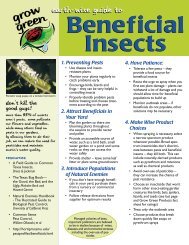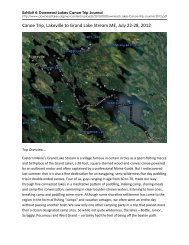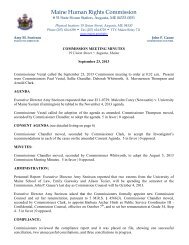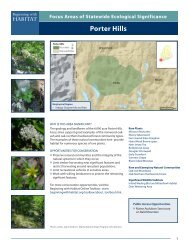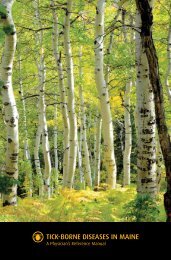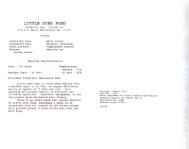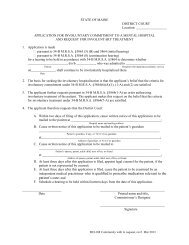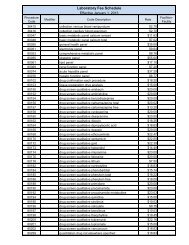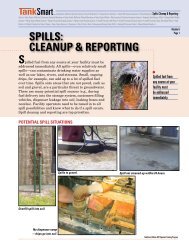Fact Sheet: Hemlock Woolly Adelgid - Maine.gov
Fact Sheet: Hemlock Woolly Adelgid - Maine.gov
Fact Sheet: Hemlock Woolly Adelgid - Maine.gov
Create successful ePaper yourself
Turn your PDF publications into a flip-book with our unique Google optimized e-Paper software.
will mature into sisten adults by early February. These adults<br />
will oviposit their eggs from March through May, which is the<br />
beginning of a new generation of HWA.<br />
Impact on <strong>Hemlock</strong>: Feeding by HWA causes the needles<br />
on infested branches to dessicate, turn grayish-green color,<br />
and then drop from the tree, sometimes within months. Most<br />
buds on infested branches are also killed as a result of feeding<br />
so little if any new growth is produced on these branches.<br />
Dieback of major limbs can occur within two years and<br />
progresses from the bottom of the tree upward, even though<br />
the infestation may be evenly distributed throughout the tree.<br />
Trees may die within four years, but as some homeowners<br />
have seen, some may survive longer with only a sparse<br />
amount of foliage at the very top of the tree. There is some<br />
evidence that some trees weakened by a HWA infestation may<br />
recover, although the factors that lead to such recovery are not<br />
well understood.<br />
Management Options in Landscapes: <strong>Hemlock</strong>s<br />
infested with HWA can be kept healthy in a landscaped setting<br />
by using an integrated management approach that includes:<br />
Taking care when moving plants, logs, firewood, or bark<br />
chips from infested to uninfested areas, especially from<br />
March through June when adelgid eggs and crawlers are abundant.<br />
Figure 3. Close-up of adult (black) HWA<br />
and eggs (orange) inside an ovisac (Michael<br />
Montgomery, USDA Forest Service,<br />
www.Bugwood.org)<br />
Water hemlocks during periods of drought. On Long Island in most seasons the critical months for watering<br />
established hemlock are June, July and August. Deep watering rather than frequent, shallow watering is<br />
recommended. Prune off all dead and dying branches. Although HWA is capable of killing hemlock<br />
growing in seemingly optimal condition those trees experiencing stress from drought and other factors<br />
succumb to adelgid attack more quickly.<br />
Fertilizing hemlock trees after HWA has been completely controlled can help encourage growth and<br />
stimulate recovery. Fertilizing infested hemlocks with nitrogen enhances HWA survival and reproduction.<br />
Therefore, nitrogen fertilizer should not be applied to infested hemlock.<br />
If you need to replace dead hemlock consider using Western species (Tsuga mertensiana (Bong.) (Carr.) or<br />
T. heterophylla (Raf.) (Sarg.)). You may also refer to Pest Resistant Hedges and Screens for Privacy for<br />
more suggestions. This list is available from Cornell Cooperative Extension – Suffolk County for a slight<br />
charge.<br />
Applying chemical insecticides is an essential component of any integrated approach to managing<br />
populations of HWA. Even if you follow all of the measures described above, infested trees are usually<br />
unable to survive for more than a few years if chemical insecticides are not used to control the infestation.<br />
It is necessary to thoroughly drench infested trees with a recommended insecticide to achieve effective results.<br />
Be sure to spray trees from top to bottom as well as on all sides. Homeowners should hire certified pesticide<br />
applicators that have the proper equipment if the trees are too tall or many trees need to be treated. Two spray<br />
treatments each year are usually necessary if a hemlock tree has a HWA infestation.<br />
Insecticide treatments suggested to homeowners: At the dormant stage (late April to early May), apply<br />
horticultural oil. In late June or late September and the following year in early June, treat with insecticidal soap.<br />
Thorough coverage with oil or soap is necessary.



